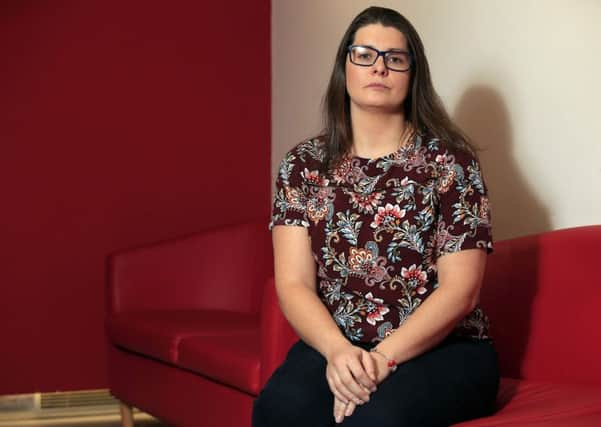With 44,000 deaths a year, why sepsis should be treated with the same urgency as heart attacks


When Melissa Mead’s one-year-old son William died, plenty of words were spoken. There was talk of how his organs had shut down and how by the time paramedics had arrived at the family home it was already too late. Not once in all the talk was the word ‘sepsis’ used.
In fact the first Melissa and her husband Paul heard of it was when read the post-mortem report into their son’s death. Assuming it must be some rare condition, the couple turned to the internet and their grief was compounded. Sepsis wasn’t rare, it was something common and had just one person joined the dots between William’s symptoms he could and should have been saved.
Advertisement
Hide AdAdvertisement
Hide Ad“William had been poorly in the two months prior to his death,” says Melissa. “He had suffered a chest infection and crucial antibiotics needed to help prevent the onset of pneumonia were not prescribed. Eventually his little chest cavity filled with nasty fluid and he succumbed to sepsis in his sleep, in his bed, at home. There was nothing that we nor the paramedics could have done.


“I’d taken William to the doctors 36 hours before he died, but no one diagnosed him appropriately or told me that the symptoms he was displaying were those of deadly sepsis.”
In January, the Mears received an apology from the Secretary of State for Health on behalf of the Government and the NHS. It criticised GPs, out-of-hours services and an 111 call handler who all failed to spot the signs of sepsis. It also recognised gaping holes in the system and a crucial lack of awareness about a condition which each year kills 44,000 a year.
Melissa found some comfort in the apology, but took more solace from yesterday’s announcement by the ational Institute for Health and Care Excellence that sepsis should be treated as an emergency in the same way as heart attacks.
Advertisement
Hide AdAdvertisement
Hide Ad“Sepsis is the second biggest killer in the UK after heart disease,” says Melissa. “It doesn’t discriminate who it affects and yet until now it doesn’t seem to have been on the radar of many GPs or emergency medical staff. The fact NICE has issued these guidelines is a momentous first step, but it is just that.


“The momentum certainly seems to be building, but we need to ensure that sepsis is as recognised as meningitis.”
Since the introduction of the ‘tumbler test’ and national awareness campaigns, annual deaths from meningitis have plummeted. While sepsis is more difficult to diagnose, it is estimated that with better education 12,500 lives could be saved and the cost to the NHS reduced by as much as £350m.
“From which ever way you look at it the cost of sepsis is huge,” says Melissa, who is currently pregnant with her second child. “ I know we were unlucky. Nine times out of 10 one of those professionals who saw William before he died would have spotted the signs and would have begun treatment, but they didn’t and we aren’t the only ones.
Advertisement
Hide AdAdvertisement
Hide Ad“The problem is that sepsis accelerates so quickly and once the vital organs begin to shut down it is often already too late. I will never dress William in his first school blazer or know whether he would have liked football or preferred to read books. We lost him, but hopefully we can make sure that other children like William do survive.”
The Bounty Packs given to all new parents will soon include a flyer on the common symptoms of sepsis and in its new guidelines, NICE has called for health professionals to think about the possibility of sepsis in all patients who may have an infection. GPs should send any patient who might have sepsis to hospital in an ambulance. Once in hospital they should be seen by a senior doctor or nurse immediately who can start treatment. The guidance also includes a checklist of signs and symptoms and details on what to do next.
Kelly Smith knows just how vital a speedy diagnosis is when it comes to sepsis. Two years ago the 34 year old veterinary nurse began to feel unwell and while she initially dismissed her aching limbs and high temperature as the start of a cold, it quickly became clear that it was something more serious.
“I never normally vomit, but I just couldn’t keep anything down,” says Kelly, from Stockton-on-Tees. “When my temperature reached 40C my mum called an out of hours service, but they dismissed it as gastroenteritis and told me to keep taking paracetamol.”
Advertisement
Hide AdAdvertisement
Hide AdWhile Kelly heeded the medical advice, her condition continued to deteriorate and 48 hours after first feeling unwell, her mother called an ambulance.
“By then I was delirious and unable to talk. Had she not been there, I wouldn’t be here now. When the paramedics arrived my blood pressure had dropped through the floor and my heart was racing. When they had stabilised me, it was straight into intensive care.”
Kelly spent nine days in ICU and while she has nothing put praise for the staff at North Tees Hospital, sepsis cast a long shadow over her life and she later suffered periods of anxiety and depression.
“It was awful. I just didn’t want to go out of the house. I gave up my job and for a while I gave up on life. I was lucky though that I had the support of a wonderful family and friends. Eventually, I thought, ‘right, this can’t go on, I need something to focus on’. It sounds silly I know, but I decided to build a garden pond. That really was the start of my recovery.”
Advertisement
Hide AdAdvertisement
Hide AdWhile Kelly’s immune system is not quite what it was and she has to be careful that colds don’t turn into anything more serious, she has now returned to work and when we speak she is on her way to Blackpool to celebrate her birthday.
“It’s been tough, but I’m now working part-time at a different veterinary practice and I’ve got a lot to look forward to. It could have been a whole lot worse, but what’s really frightening about sepsis is just how quickly it grabs hold of your body. I was young, fit and healthy, but if my mum had called the ambulance even just half an hour later I wouldn’t have been strong enough to fight it.”
It’s that crucial early diagnosis which NICE hopes will come with the new guidelines. It won’t save every life, but it will save many.
“In the months after Williams died I asked myself a thousand times, how was I supposed to know what sepsis was, if my doctor wasn’t even thinking about it,” says Melissa. “William was beautiful, a child that never failed to smile.
Advertisement
Hide AdAdvertisement
Hide Ad“The week before he died he had triumphed at taking his first independent steps and congratulated himself by clapping, a trick that he’d learnt the week before. There should have been many more landmark days, but there weren’t. William’s journey in life stopped just 11 days before Christmas, but our journey to make everyone aware of sepsis goes on.”
For more information go to sepsistrust.org